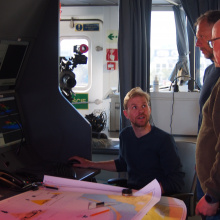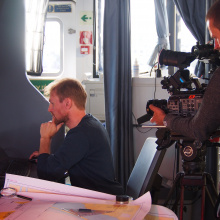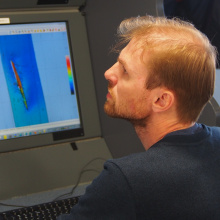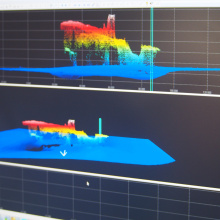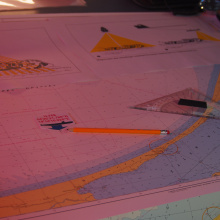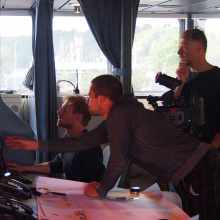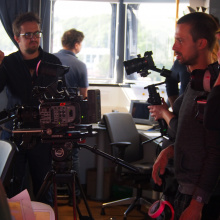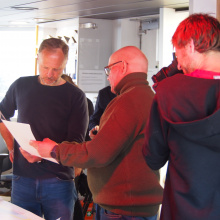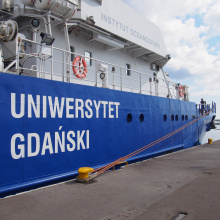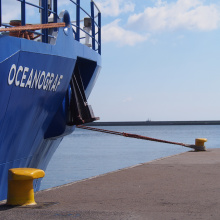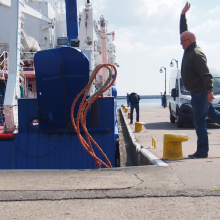On board the Oceanograf, the University's research vessel, a film crew from Canal+ was conducting interviews and taking pictures with specialists from the University's Department of Oceanography and Geography. The research will also be used by a team of divers who will be shooting a series of films entitled Mysteries of the Baltic Wrecks.
The 'hero' of one of the episodes in the series will be the wreck of a U-boat 768 discovered ten years ago, which sank in 1943 in the vicinity of the Vistula trench after a collision with another vessel and lies at a depth of 53 metres. It is one of the dozens of vessels found at the bottom of the Gulf of Gdańsk. The ship sank and became famous for its rescue operation, in which the entire 44-person crew was rescued.
The wreck will be explored by divers with a film crew during the ongoing production of the fourth episode of the series on Baltic wrecks. Some of the filming has already taken place on board the Oceanograf. The vessel is a research catamaran owned by the University.
It is the most modern vessel of its kind operating in the Baltic Sea. It is almost 50 m long and 14 m wide, and its maximum speed is 12 knots. The longest time it can stay at sea without calling at a port - its autonomy - is 21 days, and its homeport is Gdynia. - 'The Oceanograf is used both for scientific research and to train young students in marine research. It is superbly equipped with the most modern apparatus for biological, chemical, physical and geological measurements, which makes it possible to conduct advanced, interdisciplinary research of the sea at a world-class level,' explains dr hab. Waldemar Surosz prof. UG, Dean of the Faculty of Oceanography and Geography.
This made it possible to use materials created during the research, explaining the history of the submarine and wreck research in the Baltic, for the film. - 'We have the most interesting wrecks here, and they are in very good condition. The Baltic is a diving Eldorado,' argues Tomasz Stachura, a diver and explorer, the protagonist of the Canal Plus diving series, inviting us to the series' broadcast, which will begin in October this year.
Let us recall that a year ago, research work on the U-boat 768 was conducted by a team of scientists from the University of Gdańsk in cooperation with archaeologists from the University of Warsaw. The research dealt with the environmental impact of wrecks, particularly environmental magnetism, in which dr hab. Leszek Łęczyński from the University of Gdańsk's Department of Oceanography and Geography is a specialist. His research involved determining the type of sediment, its fraction and the presence of metallic particles. - 'I study the impact of particles from the process of destroying the wreck, which get into the sediment,' explains the professor.
The viewers of the popular science series will be able to see in the fourth episode not only the interior of the modern UG research catamaran but above all the operation of the state-of-the-art equipment. Its capabilities will be presented during a conversation between prof. Leszek Łęczyński and Tomasz Stachura, a diver and one of the most active explorers of wrecks in the Baltic Sea and the author of underwater photos. This equipment includes side-scan sonar and a multibeam echosounder. - 'With these devices, it is possible to measure the depth in the bottom area with an accuracy of 1 cm. The multibeam echo sounder allows you to see the image in 3D, while the sonar allows you to record the bottom in negative format, which gives us more details,' explains prof. Leszek Łęczvński.
Complete and panoramic images of the U-boat's cylindrical shape and precise location data will be extremely helpful during the exploration of the wreck for the film. The diving team, in turn, will be able to take samples from the bottom during the underwater shooting, which will enable observations and assessment of the condition of the wreck's shell. These will in turn be useful in researching sunken vessels containing chemical warfare agents, fuel and ammunition, which pose a serious threat and problem for the marine environment.


